Old Church Slavonic is believed to have been primarily based on the dialect of the 9th-century Byzantine Slavs living near Thessalonica. It played an important role in the history of the Slavic languages and served as a foundation and model for later Church Slavonic traditions. Some Eastern Orthodox and Eastern Catholic churches continue to use this later Church Slavonic as a liturgical language to this day.
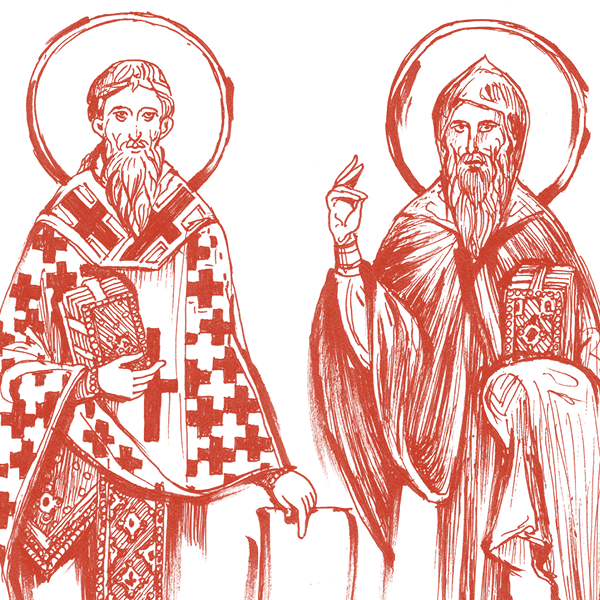
Old Church Slavonic
Old Church Slavonic (OCS) is the earliest variety of Slavic language recorded in the earliest Slavic manuscripts dating from the ninth and tenth centuries. The language was created for literary purposes, generalized from the early Southeastern/Balkan Slavic (Bulgaro-Macedonian) dialect. It was specifically created to fit the phonological inventory of the spoken Slavic idiom of Macedonia by the ninth-century Byzantine missionaries Cyril and Methodius. Their missions among the Slavs stretched from the Moravian Empire, located between the Vistula River and the easternmost extent of the Carolingian Empire, and the Bulgarian Empire, stretching from the lower areas of Macedonia in the south up beyond the Danube in the north. Cyril and Methodius devised the first full-fledged writing system to represent this language. Even though it was the dialect of Thessaloniki in the ninth century, Old Church Slavonic was probably understood by the Moravians and Pannonians of the Danube Basin.
Language
Old Church Slavonic was a literary language developed and standardized by the ninth-century missionaries Cyril and Methodius for their missionary work across the Slavic regions of Eastern and Southern Europe. They were asked to translate the Bible and other Christian texts into a language Slavic people could understand to spread Christianity more effectively.
One may speak of Old Church Slavonic from ca. 850–1100 CE. The consensus is that Old Church Slavonic's latest use was around the beginning of the twelfth century. While the spoken language was further transformed, the church language is considered to have remained the same in different areas, known as Church Slavonic. Thus, the terms Church Slavonic or Church Slavic are used for the later documents, while Old Church Slavonic or Old Church Slavic corresponds to the earlier documents. Sometimes, South Slavic manuscripts written after 1100 are called Russian-Church Slavonic, Bulgarian-Church Slavonic, Serbian-Church Slavonic, etc., or Russian, Bulgarian, Macedonian, Serbian, etc. recensions of Church Slavonic. OCS is at times termed Old Bulgarian since the earliest manuscripts originate from today’s Balkans. Finally, scholars sometimes opt for Old Slavonic, mainly when covering any or all of its medieval phases.
The differences between Old Church Slavonic and Church Slavonic are due to various regional and temporal changes. As the earliest language, the ninth-tenth-century Old Church Slavonic lacked strict orthographic rules. Besides, the spoken Slavic languages experienced wide dialectical variation in their further development, while the church language has been considered relatively consistent. Nevertheless, even medieval manuscripts (for example, from the fourteenth century) that contain religious texts display significant variations in orthography, spelling, punctuation, grammar, and vocabulary, which is especially visible when looking into the different manuscript copies of the same text. It is because the manuscripts were written at different times in different places, and the traditions and schooling of scribes prescribed different norms. Here is how some of these divergencies look like:
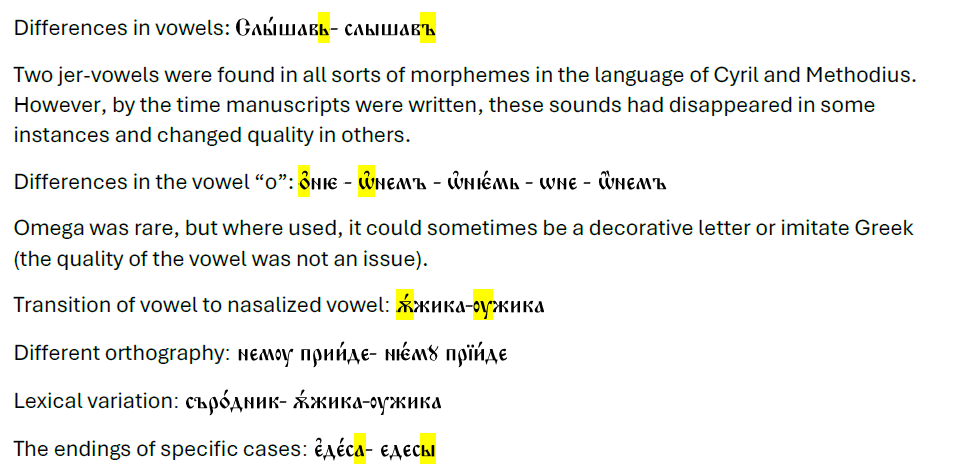
The following chart demonstrates the variations of the same text in the different medieval manuscripts:
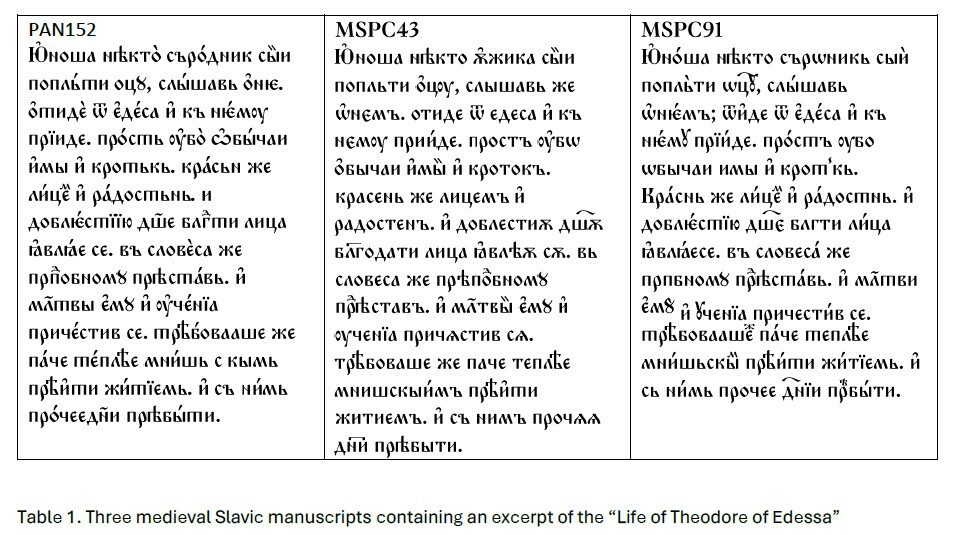
Besides its use in the ecclesiastical context, Church Slavonic remained the literary language in various East and West Slavic-speaking areas for several centuries. It eventually fell out of use as the everyday spoken languages of Slavic peoples evolved and changed. Languages developed into East, West, and South Slavic. Modern examples of this dialectal division include Russian in the East, Czech and Polish in the West, and Serbian, Croatian, and Bulgarian in the South. However, Church Slavonic remains a liturgical language in some Eastern Orthodox and Eastern Catholic churches, as they continue to use it to this day.
Script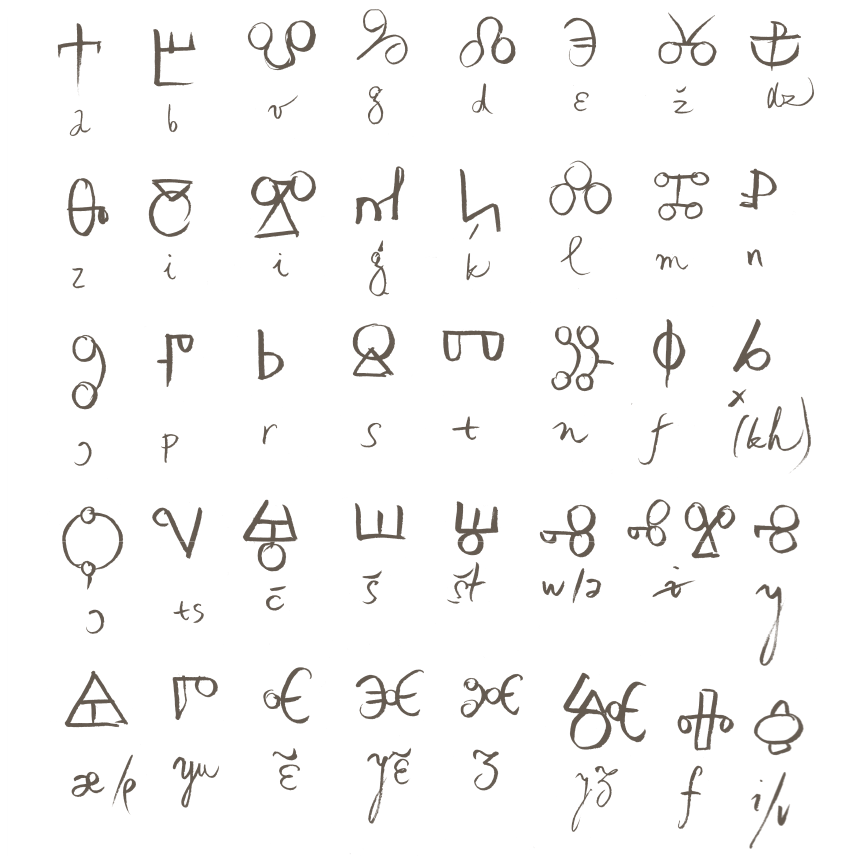
Old Church Slavonic manuscripts are written in two alphabets: Glagolitic and Cyrillic. The Glagolitic alphabet was invented by Constantine-Cyril around 863 CE, while the Cyrillic alphabet was later developed and attributed to him. The Cyrillic script adjusted many Greek majuscule letters. Although both alphabets are functionally equivalent, they are visually quite different.
The later Church Slavonic language’s use of the Cyrillic script remained unchanged from its inception in the Old Church Slavonic period. There are approximately 40 letters in the alphabet, although the exact number may vary depending on whether two symbols are considered separate letters or variations of the same letter. Interestingly, the Croatian recension of Church Slavonic has been attested in Glagolitic medieval manuscripts well into the late Middle Ages.
Literature
Old Church Slavonic literature began with translations of key biblical and ecclesiastical works, mainly from Greek. During the Cyrillo-Methodian period (the middle of the 9th century – 885), the translation work included the Psalter, the Aprakos (Lectionary), the Euangelion (Gospels), the Apostolos (Acts and Epistles), and selected Church offices. The subsequent First Bulgarian Tsardom period (886–1018), from the arrival of the disciples of Cyril and Methodios in Bulgaria until the end of the First Bulgarian Tsardom, saw an increase in translation activities. Translation efforts were centered around two main regions: Eastern Bulgarian, with important centers in Pliska and Preslav (within “Preslav School”), and Western Bulgarian, with centers in Devol (Diavoli) and Ohrid. The peak of translation activity occurred in Preslav from the late 9th to mid-10th century and in Ohrid from the mid-10th to early 11th century.
From the 11th century, translated works, particularly those of monastic and liturgical nature, including hagiographies, began to spread to medieval Rus, where they played a key role in religious life. The period from the late 11th to the early 13th century is considered the peak of translation activity in Rus. In the 13th century, Serbian translation efforts flourished, particularly at Mount Athos. Translation activity in Bulgaria continued to thrive in two significant phases: during the Second Bulgarian Tsardom (late 12th to 13th centuries) and the Athonite-Tarnovo period (14th century to early 15th century). The golden period of Slavonic literature in the territory of today’s Bulgaria is particularly reflected in the original writings of Euthymius of Tarnovo. Original medieval Serbian literature was especially cultivated from the 13th-15th century.
The earliest preserved manuscripts
The earliest Old Church Slavonic texts appear in eight extensive manuscripts (one palimpsest), two fragments, and several single folia, some of which were:
- Kyiv Folia (10th century) – the oldest Glagolitic manuscript is a translation of the Roman Missal, which contains all the texts used during Mass. With at least one Czech trait, Kiev Folia are the only known example of a variant of Old Church Slavonic that was presumably used in Bohemia and possibly in Moravia. This manuscript includes seven Glagolitic folia that are currently located in Ukraine.
- Codex Marianus (11th century, 1030) – A Gospel book written in the Glagolitic script and one of the oldest OCS manuscripts. It consists of 174 folia containing the Gospels and is now located in Russia.
- Codex Zographensis – (1020) The manuscript containing translations of the Gospels, along with a synaxarion (a compilation of the short entries referring to saints on their feast days). It consists of 271 folia in Glagolitic script, 17 folia in Old Macedonian Church Slavonic also in Glagolitic script, and later addenda in Cyrillic. This manuscript is currently held in Russia.
- Codex Suprasliensis – The late 10th-century manuscript written in Cyrillic, consisting of 285 folia, contains the Reading Menaion for the month of March. This collection includes the lives of saints for daily readings, as well as sermons for Holy Week and Easter. The manuscript was produced in Central or Eastern Bulgaria and is currently preserved in three parts, kept in Russia, Poland, and Slovenia.
- Sava’s Book (Savina Knjiga) (11th century, 1030s) – an Evangeliary written in Cyrillic. It consists of 129 folia in the central or Eastern Bulgarian dialect and is currently located in Russia.
- Codex Assemanianus (1038) – A 158-folia manuscript written in Glagolitic script, originating from Macedonia, is currently housed in the Vatican Library.
- Psalterium Sinaiticum (11th century) – The manuscript contains 151 psalms that were produced in the 1040s in Macedonia.
- Euchologium Sinaiticum (11th century) – The manuscript contains 137 folia and is presumably from Macedonia.
- Glagolita Clozianus – The manuscript consists of 14 folia of homilies written in Glagolitic script. The language exhibits influence from both Macedonian and Serbian, although the precise origin and authorship of these texts remain uncertain. Currently, it is located in Italy and Austria.
Influence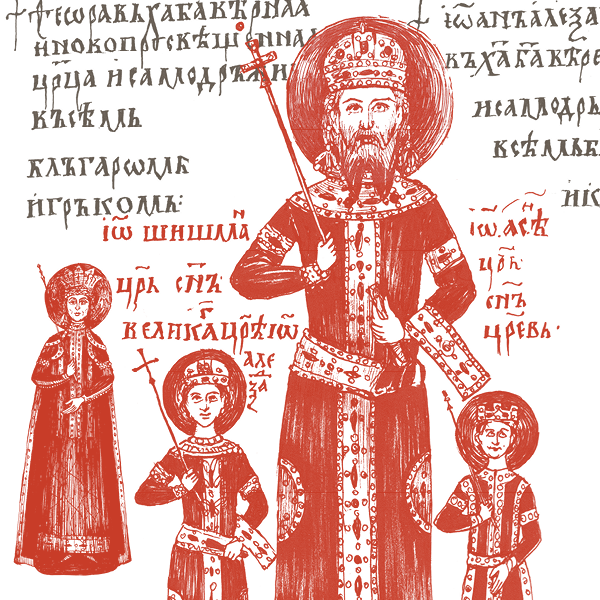
Old Church Slavonic and Church Slavonic greatly impacted the development of literature and languages in Eastern Europe. In particular, the development of the Cyrillic script laid the foundation for the later evolution of several modern alphabets, including Russian, Ukrainian, Bulgarian, Belorussian, and more. Moreover, the Old Church Slavonic has been crucial for linguistics as a tool for reconstructing the Proto-Slavic language, which is theorized to be the common ancestor of all Slavic languages lost to time.
External resources
- Wikipedia: Old Church Slavonic: https://en.wikipedia.org/wiki/Old_Church_Slavonic
- Wikipedia: Church Slavonic: https://en.wikipedia.org/wiki/Church_Slavonic
- Codex Suprasliensis: https://web.archive.org/web/20111019153103/http://csup.ilit.bas.bg/
- Codex Suprasliensis: TITUS Project: https://titus.uni-frankfurt.de/texte/etcs/slav/aksl/suprasl/supra.htm






